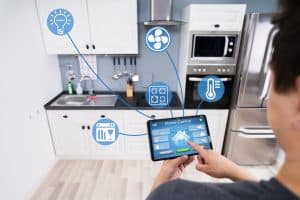Do Smart Home Features Appeal to Baby Boomer Renters?

According to data from Parks Associates, a market research and consulting firm, 14% of baby boomers—at least those living in multifamily units—own some sort of smart home device. Adoption of these devices is up 18 percentage points in the last five years among adults 65 to 74, and 9 points or more for those 75 or older.
Among multifamily builders, at least six different smart technologies rank as “highly popular features” these days, including smart thermostats, smart door locks, smart smoke detectors, and more.
Those aren’t the only technologies that boomers are flocking to, though. Let’s dive in and look more at how older renters are interacting with home technology — particularly in the wake of the COVID-19 pandemic.
The Top Smart Home Features for Boomers
According to experts, smart speakers are one of the most popular technologies that older cohorts are adopting. A whopping 36% of boomers age 65 to 74 say they have smart speakers at home.
“Smart speakers are of particular interest since they can perform a wide range of function—from entertainment to information, to serve as home control hubs, and also to enable people to call for help if needed,” says Kristen Hanich, senior analyst at Parks Associates.
That last function—calling for help—is big. According to those in the multifamily industry, many boomers like to use smart home tech to add security and safety to their properties. Popular options here include video doorbells, smart locks, and even smart sensors.
“Smart home sensors are gaining popularity with the aging population,” says Girish Gehani, chief operating officer at Trilogy Real Estate Group. “This gives someone the ability to call for help and also tracks movement within a home.”
Video doorbells and app-controlled access systems that allow tenants to safely let guests or deliveries in remotely are popular, too. According to Parks Associates data, more than a quarter of Americans 65 and older used some sort of grocery delivery service during the pandemic, while another 23% used restaurant delivery services. Smart technologies have the ability to make these services safer and more convenient—particularly for the aging population.
Adding Convenience and Comfort
Still, safety-related devices aren’t all boomers are seeking. Smart thermostats that allow owners to automate their home’s temperature—often via mobile app—are also in high demand. According to a survey of multifamily builders conducted by Parks Associates, smart thermostats are the No. 5 most popular multifamily feature these days and the top-ranking smart home feature on the list.
Other smart features it is seeing a big demand for include smart locks, smart smoke and carbon monoxide detectors, smart appliances, and smart lighting—largely items that add convenience or improve a unit’s comfort.
“Smart lighting solutions, paired with motion sensing, are also particularly useful for avoiding tripping hazards,” Hanich says. “Smart appliances—including smart ovens with safety features and alerts and smart washers and dryers should also be on people’s radars.”
Another convenience-adding item? That’d be smart hubs—like Amazon Echos, for example—that allow tenants to control their various devices with only their voice.
“Voice-activated technology has been popular,” Gehani says. “Some find it easier to use their voice than access an app to make changes to their smart home features.”
Pre-Installed Is Best
To be fair, boomers don’t just want these items in their units. They want them pre-installed before move-in.
“Looking at demand for solutions among boomers who are planning on moving, we see a lot of interest in pre-installed smart home technology,” Hanich says. “These largely follow reported adoption—smart thermostats, video doorbells, smart lighting—but also include other categories such as smart door locks, garage doors, and even independent living systems that can detect and react to emergencies.”
Boomers are hopping on the smart home wagon, and they expect their properties to follow suit.
Source: multifamilyexecutive.com















 Accessibility
Accessibility